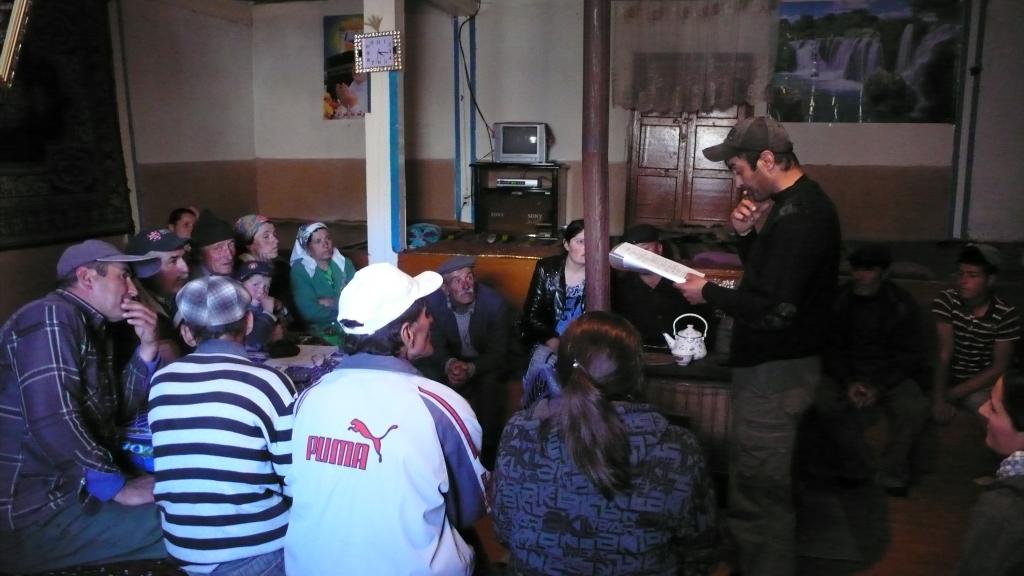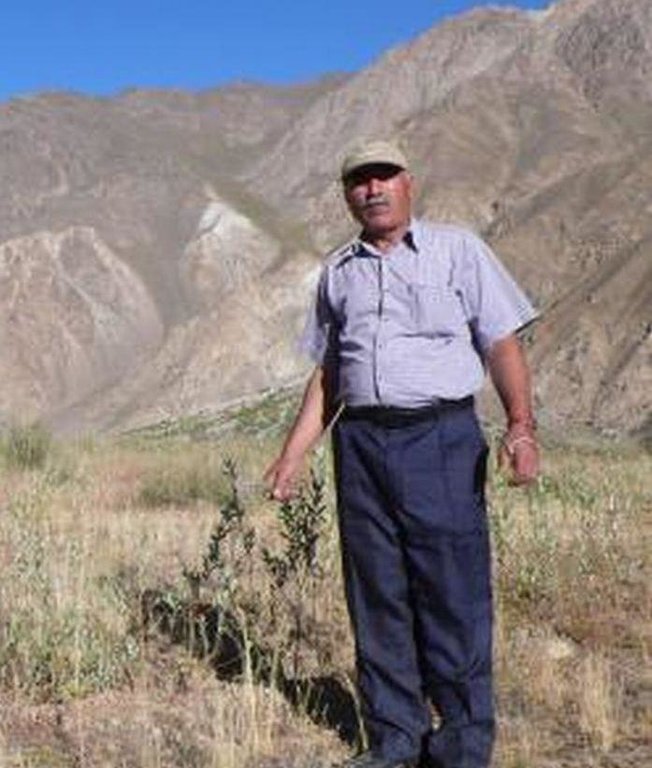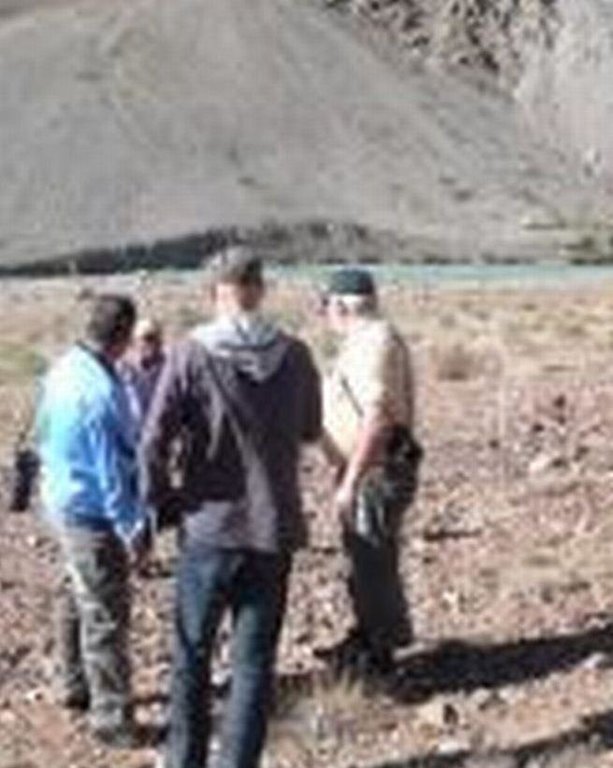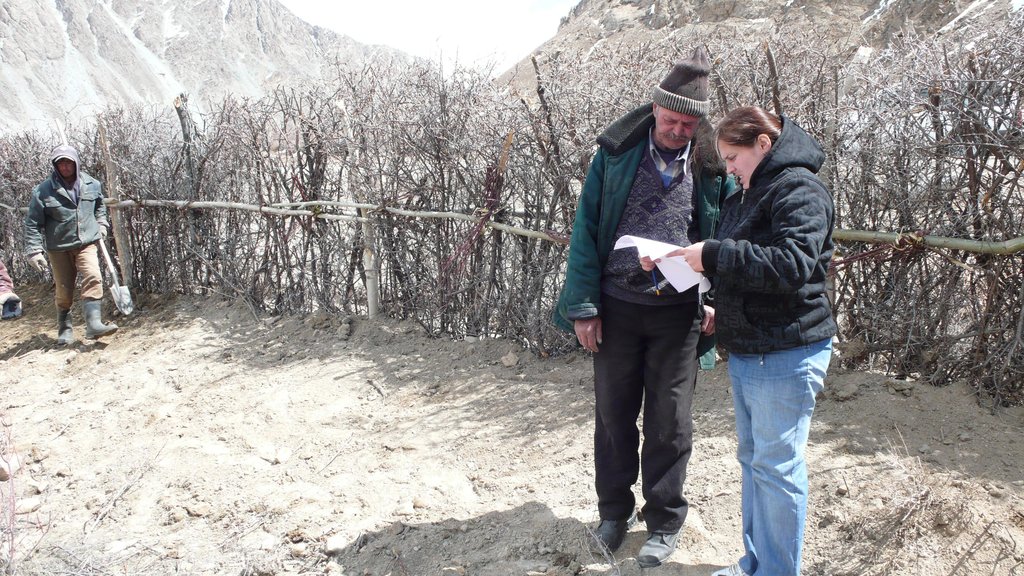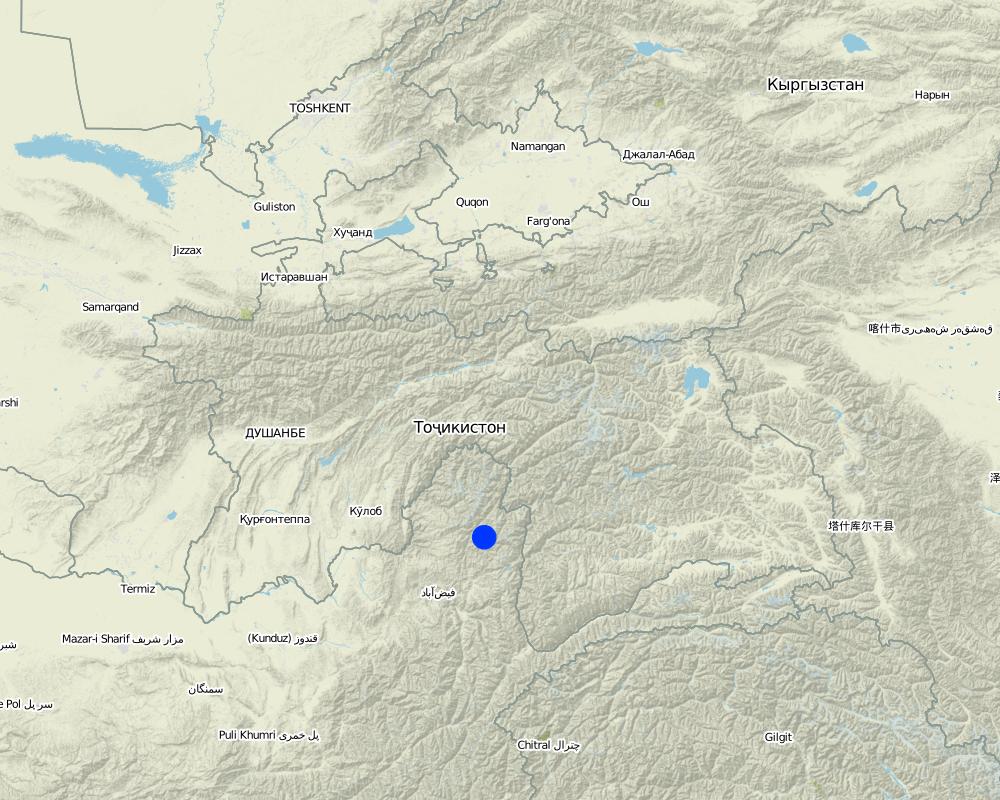Savings Book Approach [ប្រទេសតាហ្ស៊ីគីស្ថាន]
- ការបង្កើត៖
- បច្ចុប្បន្នភាព
- អ្នកចងក្រង៖ Roziya Kirgizbekova
- អ្នកកែសម្រួល៖ –
- អ្នកត្រួតពិនិត្យ David Streiff
Sberegatelnaya knizhka (Russian)
approaches_2445 - ប្រទេសតាហ្ស៊ីគីស្ថាន
ពិនិត្យមើលគ្រប់ផ្នែក
ពង្រីកមើលទាំងអស់ បង្រួមទាំងអស់1. ព័ត៌មានទូទៅ
1.2 ព័ត៌មានលម្អិតពីបុគ្គលសំខាន់ៗ និងស្ថាប័នដែលចូលរួមក្នុងការវាយតម្លៃ និងចងក្រងឯកសារនៃវិធីសាស្ត្រផ្សព្វផ្សាយ
អ្នកជំនាញឯកទេស SLM:
Neusel Benjamin
benjamin.neusel@cimonline.de
GIZ
Sustainable Management of Natural Resources in Gorno-Badakhshan, Okhonjon Str. 58-1, 736000 Khorog
ប្រទេសអាល្លឺម៉ង់
អ្នកជំនាញឯកទេស SLM:
Kirchhoff Joachim
+992 44 6006702
joachim.kirchhoff@giz.de
GIZ
Regional Program on Sustainable Use of Natural Resources in Central Asia, Ayni Str./Nazarshoev Str., 734026 Dushanbe
ប្រទេសអាល្លឺម៉ង់
ឈ្មោះអង្គភាពមួយ (ច្រើន) ដែលបានចងក្រងឯកសារ/ វាយតម្លៃលើវិធីសាស្ត្រផ្សព្វផ្សាយ (បើទាក់ទង)
Central Asian Countries Initiative for Sustainable Land Management - Multicountry Capacity Building (CACILM - MCB) - ប្រទេសកៀហ្ស៊ីស៊ីស្ថានឈ្មោះអង្គភាពមួយ (ច្រើន) ដែលបានចងក្រងឯកសារ/ វាយតម្លៃលើវិធីសាស្ត្រផ្សព្វផ្សាយ (បើទាក់ទង)
Deutsche Gesellschaft für Internationale Zusammenarbeit (GIZ) GmbH (GIZ) - ប្រទេសអាល្លឺម៉ង់1.3 លក្ខខណ្ឌទាក់ទងទៅនឹងការប្រើប្រាស់ទិន្នន័យដែលបានចងក្រងតាមរយៈវ៉ូខេត
តើពេលណាដែលទិន្នន័យបានចងក្រង (នៅទីវាល)?
15/09/2010
អ្នកចងក្រង និង(បុគ្គលសំខាន់ៗ)យល់ព្រមទទួលយកនូវលក្ខខណ្ឌនានាទាក់ទងទៅនឹងការប្រើប្រាស់ទិន្នន័យដែលបានចងក្រងតាមរយៈ វ៉ូខេត:
បាទ/ចា៎
1.4 ការយោងមួយ (ច្រើន) ទៅលើ (កម្រង) បញ្ជីសំណួរនៃបច្ចេកទេស SLM
2. ការពណ៌នាអំពីវិធីសាស្ត្រផ្សព្វផ្សាយ SLM
2.1 ពណ៌នាសង្ខេបខ្លីពីវិធីសាស្ត្រផ្សព្វផ្សាយ
Reforestation of deserted state forest plots through a financial incentive system for the labour intensive first years of forest establishment, after which harvests of forest products from the plot provide income opportunities for the forest tenants and the State Forestry Agency (in the frame of CACILM).
2.2 ពណ៌នាលម្អិតពិវិធីសាស្ត្រផ្សព្វផ្សាយ
ពណ៌នាលម្អិតពិវិធីសាស្ត្រផ្សព្វផ្សាយ:
Aims / objectives: The main objective of the approach is the reforestation of a completely deserted former forest area in collaboration with the local population. However, as reforestation is highly labour intensive especially in the initial phases, this approach was developed as an incentive system to overcome this high-labour/low-income phase.
Methods: The underlying method is the implementation of Joint Forestry Management (JFM) on severely degraded forest plots (For JFM see approach TAJ015). In order to enable reforestation on such plots, an incentive system has been developed to bridge the gap when the initial workload is high, but no forest resources can yet be harvested. Therefore, selected forest tenants receive a savings book with a total amount of money to be obtained for forest rehabilitation work within the next six years. Every year clear planting and rehabilitation goals are formulated, which have to be completed by an agreed deadline. All tenants who completed their annual tasks will get access to a share of the total amount in the savings book. The annual shares gradually decreases over a period of six years, after which access to forest resources on the rehabilitated plot will be substantial enough to provide income opportunities and forest resources for their own consumption. According to the JFM contract, forest tenants hold a plot for a period of 20 years. This also applies for the savings book tenants, who act as regular JFM tenants after the subsidised reforestation period of six years is over.
Stages of implementation: The savings book approach is designed to cover a period of six years, and includes the following; (1) Before implementation; the willingness of the local population to participate needs to be assessed, the feasibility of reforestation, costs for irrigation, possibilities and the need for fencing and possible conflicts and challenges that might occur. (2) In the first year a living fence (seabuckthorn) has to be established, and the irrigation system has to be fully rehabilitated. (3) During the first three years of the approach implementation tenants will reforest one third of their plot each year (1-2 ha per household), introducing a rotation system that will be used for harvesting. (4) During years 4-6, mainly maintenance work will be conducted (pruning, fence and irrigation maintenance).
Role of stakeholders: The JFM rental contract is valid for 20 years and defines the rights and duties of the forest tenants and the State Forestry Agency. While the tenant is responsible for the agreed annual reforestation tasks, the Forestry Agency provides the required planting material, technical support and monitoring. The Micro Loan Organisation MADINA, facilitates the financial transactions required for the implementation and management of the savings books.
2.3 រូបភាពនៃវិធីសាស្ត្រផ្សព្វផ្សាយ
2.5 ប្រទេស/តំបន់/ទីតាំងកន្លែង ដែលវិធីសាស្ត្រផ្សព្វផ្សាយត្រូវបានអនុវត្តន៍
ប្រទេស:
ប្រទេសតាហ្ស៊ីគីស្ថាន
តំបន់/រដ្ឋ/ខេត្ត:
Tajikistan, Gorno Badakhshan Autonomous Region
បញ្ជាក់បន្ថែមពីលក្ខណៈនៃទីតាំង:
Shugnan
Map
×2.6 កាលបរិច្ឆេទនៃការចាប់ផ្តើម និងបញ្ចប់នៃវិធីសាស្រ្តផ្សព្វផ្សាយនេះ
សូមបញ្ជាក់ឆ្នាំដែលបានបង្កើតឡើង:
2010
ឆ្នាំបញ្ចប់ (ប្រសិនបើវិធីសាស្ត្រផ្សព្វផ្សាយត្រូវបានឈប់ប្រើប្រាស់):
2012
2.7 ប្រភេទនៃវិធីសាស្ត្រផ្សព្វផ្សាយ
- ផ្អែកលើគម្រោង/កម្មវិធី
2.8 គោលបំណង/ទិសដៅសំខាន់នៃវិធីសាស្ត្រផ្សព្វផ្សាយ
The Approach focused mainly on SLM with other activities (Income generation, income diversification, reforestation of severely degraded forest areas, improved access to forest resources)
Reforestation and protection of severely degraded state forest plots in cooperation with the local forest users. At the same time, providing an incentive system for the initial reforestation phase, when a high workload is required but no forest products can be harvested. The main objective is therefore to combine forest rehabilitation with livelihood improvement (increased income generation and forest resource accessibility) and to directly involve the local population in the management and rehabilitation of the State forest resources close to their village. The approach will be implemented within the framework of Joint Forestry Management (see approach TAJ015).
The SLM Approach addressed the following problems: The forest area close to the village was completely destroyed during the civil war to meet urgent fuelwood needs. At the same time the State Forestry Agency does not have the necessary financial, management and control capacities to reforest degraded areas. Despite the presence of a forested area close to the village, local inhabitants do not have the labour force and the financial resources to rehabilitate the plot and the irrigation infrastructure on their own. These highly degraded or deserted forest plots aim to be re-established through the savings book approach, by combining long-term rental contracts for individual plots, financial incentives for the initial reforestation efforts, and user rights to the resources growing on the plot in future.
2.9 លក្ខខណ្ឌអនុញ្ញាត ឬរារាំងការអនុវត្តន៍បច្ចេកទេសដែលស្ថិតនៅក្រោមវិធីសាស្រ្តផ្សព្វផ្សាយ
ភាពអាចរកបាននៃធនធានហិរញ្ញវត្ថុ និងសេវាកម្ម
- រារាំង
On highly degraded plots the initial labour and financial input for reforestation is very high and cannot be met either by forest tenants nor by the State Forestry Agency.
Treatment through the SLM Approach: The plots are rented to local forest tenants, who receive a savings book with a certain amount of money for rehabilitation activities for six years. The work is strictly monitored and money can be accessed only if the annual tasks are completed.
បរិបទនៃស្ថាប័ន
- រារាំង
The State Forestry Agency lacks the institutional capabilities to implement, manage and control reforestation and forest management activities.
Treatment through the SLM Approach: Income opportunities are handed over to local forest tenants. Forestry Agency staff are also trained in monitoring and sustainable management of the rented plots.
ក្របខណ្ឌច្បាប់ (សិទ្ធិកាន់កាប់ដីធ្លី កម្មសិទ្ធីប្រើប្រាស់ដីនិងទឹក)
- រារាំង
Local inhabitants had no official user rights to the state forest plots close to their village and were using the plots illegally. Hence there is no real interest in rehabilitating the plots.
Treatment through the SLM Approach: The forest plots are rented and contracts, management and annual plans are established for each plot. Additionally, the major costs for reforestation are covered for the first few work intensive years.
The existing land ownership, land use rights / water rights moderately hindered the approach implementation Before the implementation of this approach the deserted forest area was governed by open access, although it formally belonged to the State Forestry Agency. Local villagers used it intensely as winter pastures. Therefore, not everybody was happy to restrict access to the area. However, it is clear to the local land users, that reforestation and irrigation rehabilitation will enable better access to forest products and fodder in the long run.
ចំណេះដឹងស្តីពី SLM និងការទទួលបានការគាំទ្រផ្នែកបច្ចេកទេស
- រារាំង
The State Forestry Agency lacks financial and technical resources to rehabilitate degraded forest areas and the respective irrigation infrastructure.
Treatment through the SLM Approach: Shortcomings in irrigation are analysed and improved at the beginning of rental agreements with local villagers. Technical and financial support from the project is provided where infrastructure needs much assistance.
ទំហំការងារ ភាពអាចរកបាននៃកម្លាំងពលកម្ម
- រារាំង
After the collapse of the Soviet Union, the State Forestry Agency had insufficient financial and human resources to manage the state forests.
Treatment through the SLM Approach: Through Joint Forestry Management and hence also through the savings book approach the workload in the forest (but also the incomes from forest products) is shared with local forest tenants.
3. ការចូលរួម និងតួនាទីរបស់ភាគីពាក់ព័ន្ធ
3.1 អ្នកពាក់ព័ន្ធដែលបានចូលរួមក្នុងវិធីសាស្ត្រផ្សព្វផ្សាយ និងតួនាទីរបស់ពួកគេ
- អ្នកប្រើប្រាស់ដីក្នុងតំបន់/សហគមន៍
Forest plot tenants are the central implementing actors for reforestation
The approach is open to all economical categories within the village, regardless of age, status or ethnicity.
Several seminars on the design and implementation of the approach were held, whereas the whole community was invited, including men and women, young and old villagers
Although women and men were equally invited and encouraged to participate in the information seminars, most of the women felt that the work that would need to be done would need to be carried out by men.
As the work to be conducted was described as hard and strenuous, no women wanted to hold a forest plot under the savings book approach. However, women participated in discussions on the implementation of the approach and sometimes also took the place of men regarding decision making and implementation.
- អ្នកឯកទេសគ្រប់គ្រងដីប្រកបដោយចីរភាព/ទីប្រឹក្សាបច្ចេកទេសកសិកម្ម
Specialists from the project and the State Forestry Agency were the main actors for the design of the approach and its adaptation to local conditions
Initially developed in Vietnam, the approach was adapted and further developed by the GIZ project. During the design process, international as well as national specialists were involved, and inputs from local forest users were integrated as well.
- វិស័យឯកជន
Micro-loan organisation MADINA
- រដ្ឋាភិបាលថ្នាក់មូលដ្ឋាន
Governmental decision makers in the sphere of forestry and environmental management (State Forestry Agency of GBAO and Shugnan District)
- អង្គការអន្តរជាតិ
Deutsche Geselschaft für Internationale Zusammenarbeit GmbH (GIZ)
3.2 ការចូលរួមរបស់អ្នកប្រើប្រាស់ដីក្នុងតំបន់/ សហគមន៍ក្នុងតំបន់ក្នុងដំណាក់កាលផ្សេងគ្នានៃវិធីសាស្រ្តផ្សព្វផ្សាយ
| ការចូលរួមរបស់អ្នកប្រើប្រាស់ដីក្នុងតំបន់/សហគមន៍ក្នុងតំបន់ | សូមបញ្ជាក់នរណាត្រូវបានចូលរួម ព្រមទាំងពណ៌នាសកម្មភាពទាំងនោះ | |
|---|---|---|
| ការចាប់ផ្តើម/ការលើកទឹកចិត្ត | អន្តរកម្ម | Initial field visits, information seminars, discussions, involvement of the whole community. |
| ការរៀបចំផែនការ | អន្តរកម្ម | The technical planning of the approach was mainly conducted by forestry specialists, whereas the local villagers were consulted in an interactive way in order to adapt the approach to the specific conditions on site (e.g. solution of irrigation problem, planting techniques etc.). |
| ការអនុវត្តន៍ | ការគាំទ្រពីខាងក្រៅ | After the initial reforestation phase the tenants will be involved in the participatory JFM system. |
| ការត្រួតពិនិត្យ និងវាយតម្លៃ | អន្តរកម្ម | Progress and results are monitored in close cooperation between the State Forestry Agency, the plot tenants and project staff. Successes and challenges are documented and discussed, which if needed lead to an adaptation in the approach design. |
| Research | អសកម្ម | Research is currently being conducted at a the local level, involving the local population as well as Forestry Agency staff for interviews and field visits. |
3.4 ការសម្រេចចិត្តលើការជ្រើសរើសបច្ចេកទេស SLM
សូមបញ្ជាក់តើអ្នកណាជាអ្នកបានសម្រេចចិត្តក្នុងការជ្រើសរើសបច្ចេកទេសដើម្បីយកមកអនុវត្តន៍:
- អ្នកជំនាញឯកទេស SLM បន្ទាប់ពីបានប្រឹក្សាយោបល់ជាមួយអ្នកប្រើប្រាស់ដី
ចូរពន្យល់:
The savings book approach was initially developed and tested in Vietnam. The idea to implement such an approach in GBAO came from a GIZ project. Nevertheless, the local population was involved in several discussions about the adaptation of the approach to the local conditions.
Decisions on the method of implementing the SLM Technology were made by mainly by SLM specialists with consultation of land users
4. ជំនួយបច្ចេកទេស ការកសាងសមត្ថភាព និងការគ្រប់គ្រងចំណេះដឹង
4.1 ការកសាងសមត្ថភាព/ បណ្តុះបណ្តាល
តើវគ្គបណ្តុះបណ្តាលបានផ្តល់ឱ្យអ្នកប្រើប្រាស់ដី/អ្នកពាក់ព័ន្ធផ្សេងៗទៀតដែរឬទេ?
បាទ/ចា៎
សូមបញ្ជាក់តើអ្នកណាត្រូវបានបណ្តុះបណ្តាល:
- អ្នកប្រើប្រាស់ដី
- បុគ្គលិកចុះទីវាល/អ្នកផ្តល់ប្រឹក្សាយោបល់
ប្រសិនទាក់ទង សូមបញ្ជាក់ ភេទ អាយុ ស្ថានភាពគ្រួសារ ជនជាតិដើមភាគតិច។ល។:
As for JFM (see approach TAJ015), in the first step 'mobilisers' and Forestry Agency staff were trained as field staff. In the second step, they provided training, information and advice for the forest tenants.
ទម្រង់នៃការបណ្តុះបណ្តាល:
- អនុវត្តន៍ជាមួយការងារ
- ទីតាំងបង្ហាញ
- ការប្រជុំជាសាធារណៈ
- វគ្គបណ្តុះបណ្តាល
ប្រធានបទបណ្តុះបណ្តាល:
Sustainable natural resource management, technical forest management (cutting and planting of trees, maintenance of a forest area, building of living seabuckthorn fences), elaboration of management plans and annual plans for a sustainable and joint management of the forest plot between forest tenants and the State Forestry Agency.
4.2 សេវាផ្តល់ប្រឹក្សាយោបល់
តើអ្នកប្រើប្រាស់ដីបានទទួលនូវសេវាផ្តល់ប្រឹក្សាដែរ ឬទេ?
បាទ/ចា៎
សូមបញ្ជាក់ប្រសិនបើសេវាកម្មប្រឹក្សាយោបល់ត្រូវបានផ្តល់ឱ្យ:
- នៅលើដីរបស់អ្នកប្រើប្រាស់ដី
ពណ៌នា/ពន្យល់:
Name of method used for advisory service: Forestry training for tenants; Key elements: Sustainable natural resource management and use, Technical training in forestry management (planting and harvesting, fencing etc.)
Advisory service is quite adequate to ensure the continuation of land conservation activities; Strong interest from tenants as well as State Forestry Agency to continue with this approach. However, due to the short time the approach is being implemented, still more training and practice will be needed to ensure an experienced, effective and reliable advisory service by Forestry Agency staff.
4.3 ការពង្រឹងសមត្ថភាពស្ថាប័ន (ការអភិរឌ្ឍន៍អង្គភាព)
តើស្ថាប័នទាំងអស់ត្រូវបានបង្កើតឡើង ឬពង្រឹងសមត្ថភាពតាមរយៈវិធីសាស្ត្រផ្សព្វផ្សាយដែរ ឬទេ?
- បាទ/ច៎ា ជាមធ្យម
សូមបញ្ជាក់ថាតើស្ថាប័នត្រូវបានពង្រឹង ឬបង្កើតឡើងនៅត្រឹមកម្រិតណា(ច្រើន)?
- ថ្នាក់មូលដ្ឋាន
សូមបញ្ជាក់ប្រភេទនៃការគាំទ្រ:
- ហិរញ្ញវត្ថុ
- ការកសាងសមត្ថភាព/ បណ្តុះបណ្តាល
សូមផ្តល់ព័ត៌មានបន្ថែមទៀតឱ្យបានលម្អិត:
The State Forestry Agency is being trained and supported to implement and monitor the approach on their own, and to offer advisory services. Additionally the forest tenants are encouraged and supported to act as a group and to advocate their needs and problems as a local civil society organisation
4.4 ការត្រួតពិនិត្យ និងវាយតម្លៃ
តើការត្រួតពិនិត្យ និងវាយតម្លៃគឺជាផ្នែកមួយនៃវិធីសាស្ត្រដែរឬទេ?
បាទ/ចា៎
មតិយោបល់:
technical aspects were ad hoc monitored by project staff, government through observations; indicators: condition of the irrigation and fencing infrastructure
socio-cultural aspects were ad hoc monitored by project staff, land users through observations; indicators: discussion of problems and challenges
economic / production aspects were regular monitored by project staff, government through observations; indicators: control of planting process, technical advice
economic / production aspects were regular monitored by project staff, government through measurements; indicators: control of seedlings planted (first 4 years), amount of harvested forest products (from 5th year on)
area treated aspects were regular monitored by project staff, government through measurements; indicators: monitoring of area planted at the end of planting period, enable withdrawal of money if satisfactory
management of Approach aspects were ad hoc monitored by project staff through observations; indicators: monitoring of successes and challenges, adaptation of approach if needed
management of Approach aspects were regular monitored by project staff through measurements; indicators: allocated funds to forest tenants, overall performance of approach: reforestation achieved
There were several changes in the Approach as a result of monitoring and evaluation: As the Saving Book Approach is implemented as a pilot project, results from monitoring and evaluation were mainly collected as lessons learnt, which will be highly helpful to adapt and perfectionnate the approach for further implementation sites.
There were no changes in the Technology as a result of monitoring and evaluation: None
4.5 ការស្រាវជ្រាវ
តើការស្រាវជ្រាវ គឺជាផ្នែកមួយនៃវិធីសាស្រ្តដែរឬទេ?
បាទ/ចា៎
- socio-economic, on-site situation analysis
សូមផ្តល់ព័ត៌មានបន្ថែមទៀតឱ្យបានលម្អិត និងចង្អុលបង្ហាញនរណាដែលបានធ្វើការស្រាវជ្រាវ:
A Tajik Masters student enrolled at the university of Bayreuth is currently conducting transdisciplinary field research on the perception, willingness to participate and opportunities for further distribution of the approach in GBAO. The results will help to develop a model for further evaluation of potential sites for the approach and to identify areas of difficulty.
Research was carried out both on station and on-farm
5. ថវិកា និងសម្ភារៈឧបត្ថម្ភពីខាងក្រៅ
5.1 ថវិកាប្រចាំឆ្នាំសម្រាប់ផ្សព្វផ្សាយ SLM
ប្រសិនបើចំនួនពិតប្រាកដនៃថវិកាប្រចាំឆ្នាំមិនត្រូវបានដឹងច្បាស់ សូមប្រាប់ពីចន្លោះនៃថវិកានោះ:
- 10,000-100,000
មតិយោបល់ (ឧ. ប្រភពសំខាន់នៃមូលនិធិ/ម្ចាស់ជំនួយចំបង):
Approach costs were met by the following donors: local community / land user(s) (Local forest plot tenants): 10.0%; international (Deutsche Geselschaft für Internationale Zusammenarbeit GmbH (GIZ)): 80.0%; private sector (Micro-loan organisation MADINA): 5.0%; local government (district, county, municipality, village etc) (State Forestry Agency of GBAO and Shugnan District): 5.0%
5.2 ការគាំទ្រផ្នែកហិរញ្ញវត្ថុ / សម្ភារៈដែលបានផ្តល់ទៅឱ្យអ្នកប្រើប្រាស់ដី
តើអ្នកប្រើប្រាស់ដីបានទទួលការគាំទ្រផ្នែកហិរញ្ញវត្ថ/សម្ភារៈសម្រាប់ការអនុវត្តន៍បច្ចេកទេសដែរឬទេ:
បាទ/ចា៎
ប្រសិនបាទ/ច៎ា សូមបញ្ជាក់ប្រភេទ(ច្រើន)នៃការគាំទ្រ លក្ខខណ្ឌ និងអ្នកផ្តល់ឱ្យ(ច្រើន):
As the approach aims to reforest strongly degraded forest areas, the forest tenants are rewarded with financial compensation for the initial years without direct income opportunities from the plot.
5.3 សូមបញ្ជាក់ពីធាតុចូលត្រូវបានផ្តល់បដិភាគ (រួមទាំងកម្លាំងពលកម្ម)
- សម្ភារៈ
| សូមបញ្ជាក់ ធាតុចូលណាខ្លះដែលបានផ្តល់បដិភាគ | កម្រិតទំហំប៉ុណ្ណា | សូមបញ្ជាក់ពីការបដិភាគ |
|---|---|---|
| ម៉ាស៊ីន | ផ្តល់ហិរញ្ញវត្ថុមួយផ្នែក | partly excavator work |
| ឧបករណ៍ | ផ្តល់ហិរញ្ញវត្ថុមួយផ្នែក | hand tools |
- កសិកម្ម
| សូមបញ្ជាក់ ធាតុចូលណាខ្លះដែលបានផ្តល់បដិភាគ | កម្រិតទំហំប៉ុណ្ណា | សូមបញ្ជាក់ពីការបដិភាគ |
|---|---|---|
| seedlings | ផ្តល់ហិរញ្ញវត្ថុមួយផ្នែក | |
- ហេដ្ឋារចនាសម្ព័ន្ធ
| សូមបញ្ជាក់ ធាតុចូលណាខ្លះដែលបានផ្តល់បដិភាគ | កម្រិតទំហំប៉ុណ្ណា | សូមបញ្ជាក់ពីការបដិភាគ |
|---|---|---|
| Irrigation infrastructure | ផ្តល់ហិរញ្ញវត្ថុទាំងស្រុង | rehabilitation of irrigation channel and fence |
- ផ្សេងៗ
| ផ្សេងៗ (បញ្ចាក់) | កម្រិតទំហំប៉ុណ្ណា | សូមបញ្ជាក់ពីការបដិភាគ |
|---|---|---|
| Transport costs (planting and fencing material) | ផ្តល់ហិរញ្ញវត្ថុទាំងស្រុង | Fuel and rent of lorry |
ប្រសិនបើកម្លាំងពលកម្មធ្វើដោយអ្នកប្រើប្រាស់ដី តើវាជាធាតុចូលដ៏សំខាន់មួយដែរ ឬទេ:
- បង់ជាសាច់ប្រាក់
មតិយោបល់:
Labour was carried out voluntarily as well
5.4 ឥណទាន
តើឥណទានដែលបានផ្តល់នៅក្រោមវិធីសាស្ត្រផ្សព្វផ្សាយសម្រាប់សកម្មភាព SLM នេះយ៉ាងដូចម្តេច?
ទេ
5.5 ការលើកទឹកចិត្ត ឬវិធីសាស្ត្រដ៏ទៃទៀត
តើមានការលើកទឹកចិត្តផ្សេងទៀត ឬឧបករណ៍ប្រើប្រាស់ដើម្បីលើកកម្ពស់ការអនុវត្តន៍បច្ចេកទេស SLM?
បាទ/ចា៎
បើបាទ/ចា៎ សូមបញ្ជាក់:
The State Forestry Agency is being trained and supported to implement and monitor the approach on their own, and to offer advisory services. Additionally the forest tenants are encouraged and supported to act as a group and to advocate their needs and problems as a local civil society organisation
6. ការវិភាគរកផលប៉ះពាល់ និងសេចក្តីសន្និដ្ឋាន
6.1 ផលប៉ះពាល់នៃវិធីសាស្ត្រផ្សព្វផ្សាយ
តើវិធីសាស្ត្រផ្សព្វផ្សាយជួយអ្នកប្រើប្រាស់ដីដើម្បីអនុវត្តន៍ និងថែទាំបច្ចេកទេស SLM?
- ទេ
- បាទ/ច៎ា បន្តិចបន្តួច
- បាទ/ច៎ា ជាមធ្យម
- បាទ/ច៎ា បានខ្លាំង
The deserted forest area is being reforested for the benefit of the villagers and the State Forestry Agency. Due to the establishment of contracts with the local population they acquire ownership and responsibility for the forest areas close to their village.
តើវិធីសាស្ត្រផ្សព្វផ្សាយនេះផ្តល់សិទ្ធិអំណាចដល់សង្គមនិងសេដ្ឋកិច្ចដែលក្រុមមិនទទួលបានផលប្រយោជន៍?
- ទេ
- បាទ/ច៎ា បន្តិចបន្តួច
- បាទ/ច៎ា ជាមធ្យម
- បាទ/ច៎ា បានខ្លាំង
As disadvantaged groups are more dependent on the diversification of income sources, the most susceptible households could benefit from generated income through reforestation work.
តើវិធីសាស្ត្រផ្សព្វផ្សាយបានឱ្យប្រសើរឡើងនូវបញ្ហាកាន់កាប់ដីធ្លី/សិទ្ធិអ្នកប្រើប្រាស់ដែលរារាំងដល់ការអនុវត្ត SLM?
- ទេ
- បាទ/ច៎ា បន្តិចបន្តួច
- បាទ/ច៎ា ជាមធ្យម
- បាទ/ច៎ា បានខ្លាំង
Via the approach clear property and user rights have been established. Of course conflicts have so far appeared during the whole implementation process, which are being discussed whenever they occur. However, clear user rights have stopped the open access scenario and provide incentives for labour investments in conservation and reforestation activities.
Did other land users / projects adopt the Approach?
- ទេ
- បាទ/ច៎ា បន្តិចបន្តួច
- បាទ/ច៎ា ជាមធ្យម
- បាទ/ច៎ា បានខ្លាំង
As the pilot project is still running no other sites have been started yet. However, there is strong interest from the forest tenants as well as the State Forestry Agency to further disseminate the approach.
Did the Approach lead to improved livelihoods / human well-being?
- ទេ
- បាទ/ច៎ា បន្តិចបន្តួច
- បាទ/ច៎ា ជាមធ្យម
- បាទ/ច៎ា បានខ្លាំង
So far no increase of income or own consumption of forest products from the plot has been reached. But forest tenants get income from their savings book according to the amount of work they have done
Did the Approach help to alleviate poverty?
- ទេ
- បាទ/ច៎ា បន្តិចបន្តួច
- បាទ/ច៎ា ជាមធ្យម
- បាទ/ច៎ា បានខ្លាំង
Income from the savings book reduces economic vulnerability during hard times.
6.2 ការលើកទឹកចិត្តចម្បងៗរបស់អ្នកប្រើប្រាស់ដីសម្រាប់ការអនុវត្តបច្ចេកទេស SLM
- បង្កើនផលិតកម្ម
Increased wood production for own consumption and market
- ការចំណាយ/បដិភាគ
Payments of incentives for initial reforestation contribute to livelihood
- ច្បាប់ និងបទបញ្ជា (ផាកពិន័យ)/ការប្រតិបត្តិ
Contract based legal access to forest resources
- ការកែលម្អសោភ័ណ្ឌភាព
A green forest area improves attractiveness of the village surroundings
- well-being and livelihoods improvement
Income for reforestation and access to fresh resources improve local livelihoods
6.3 សកម្មភាពផ្សព្វផ្សាយដែលប្រកបដោយចីរភាព
តើអ្នកប្រើប្រាស់ដីអាចធ្វើឱ្យមានចីរភាពនូវអ្វីដែលត្រូវបានអនុវត្តន៍តាមរយៈវិធីសាស្ត្រផ្សព្វផ្សាយដែរឬទេ(ដោយពុំមានការគាំទ្រពីអ្នកខាងក្រៅ)?
- មិនប្រាកដ
ប្រសិន ទេ ឬមិនប្រាកដសូមបញ្ជាក់ និងពន្យល់:
Currently the approach is still in its testing phase. However, the savings book approach has been designed in a way to ensure sustainability, as after the work-intensive initial phase, the forest tenants will be able to generate income from the forest resources.
6.4 ភាពខ្លាំង/ គុណសម្បត្តិនៃវិធីសាស្ត្រផ្សព្វផ្សាយ
| ភាពខ្លាំង/ គុណសម្បត្តិ/ ឱកាស ទស្សនៈរបស់អ្នកប្រើប្រាស់ដី |
|---|
| A financial incentive system bridges the period where a lot of work input is required, but the plot still doesn't provide any benefit. (How to sustain/ enhance this strength: Provide advisory and regular monitoring in order to allow the tenants to achieve the fixed annual goals and get access to their annual share of money.) |
| In the long run, forest tenants have a benefit from the reforested plot in the form of legal access to forest products (firewood, timber, hay, fruits and berries etc.). (How to sustain/ enhance this strength: Support the creation of marketing opportunities for forest products.) |
| ភាពខ្លាំង/ គុណសម្បត្តិ/ ឱកាស ទស្សនៈរបស់បុគ្គលសំខាន់ៗ |
|---|
| Completely deforested former forest plots can be reforested and livelihoods sustained at the same time. (How to sustain/ enhance this strength: Foster trust between the State Forestry Agency and the local forest tenants.) |
| Sustainable management of the plot in future is enabled through JFM. (How to sustain/ enhance this strength: Support ownership creation for the reforested area among tenants and the Forestry Agency.) |
6.5 ភាពខ្សោយ/ គុណវិបត្តិនៃវិធីសាស្ត្រ និងរកដំណោះស្រាយ
| ភាពខ្សោយ/ គុណវិបត្តិ/ ហានិភ័យ ទស្សនៈរបស់អ្នកប្រើប្រាស់ដី | តើបច្ចេកទេសទាំងនោះបានដោះស្រាយបញ្ហាដូចម្តេច? |
|---|---|
| Benefits from the forest plot will be possible only after 5 to 6 years. | Bridge the initial phase with income from the savings book, build up marketing opportunities for the forest products to be harvested in future. |
| The plot will no longer be freely accessible for other land use types such as grazing of livestock. | Provide platforms to discuss arising conflicts, show and support opportunities for winter fodder production on the forest plot. |
| ភាពខ្សោយ/ គុណវិបត្តិ/ ហានិភ័យក្នុងទស្សនៈរបស់បុគ្គលសំខាន់ៗ | តើបច្ចេកទេសទាំងនោះបានដោះស្រាយបញ្ហាដូចម្តេច? |
|---|---|
| Through the high initial labour input the costs for the implementation of this approach are rather high. | Document and promote experiences of the pilot project, enable dissemination, as the establishment of larger areas reduce the costs per ha. |
| The approach is designed for a time period of a minimum of six years, at the end of which there might be less external technical support. | Continue and improve training of Forestry Agency staff to enable a sustainable continuation. |
7. ឯកសារយោង និងវេបសាយ
7.1 វិធីសាស្ត្រ/ ប្រភពនៃព័ត៌មាន
- តាមការចុះទីវាល ការស្រាវជ្រាវនៅទីវាល
- ការសម្ភាសន៍ជាមួយអ្នកប្រើប្រាស់ដី
ការតភ្ជាប់ និងម៉ូឌុល
ពង្រីកមើលទាំងអស់ បង្រួមទាំងអស់ការតភ្ជាប់
គ្មានការតភ្ជាប់
ម៉ូឌុល
គ្មានម៉ូឌុល


